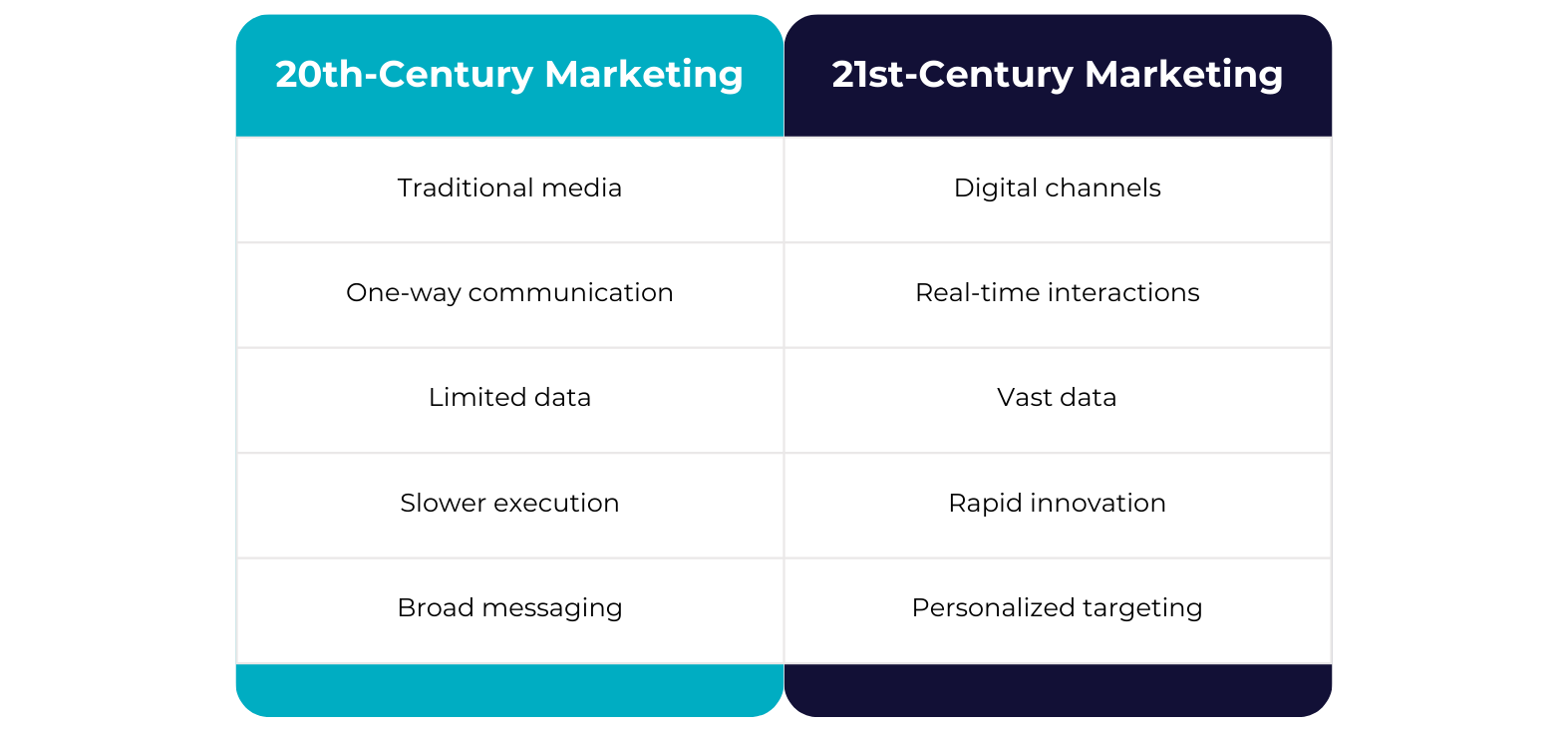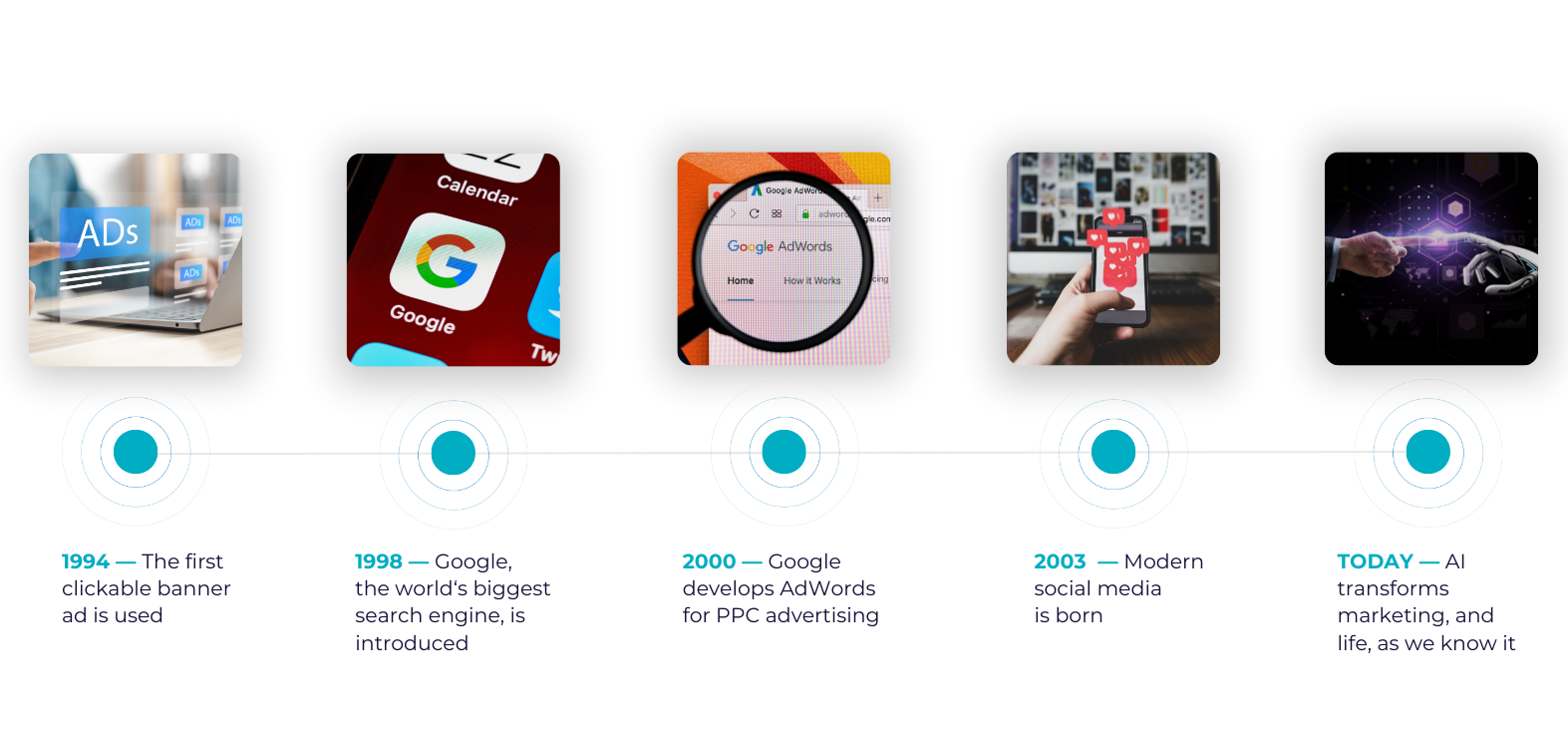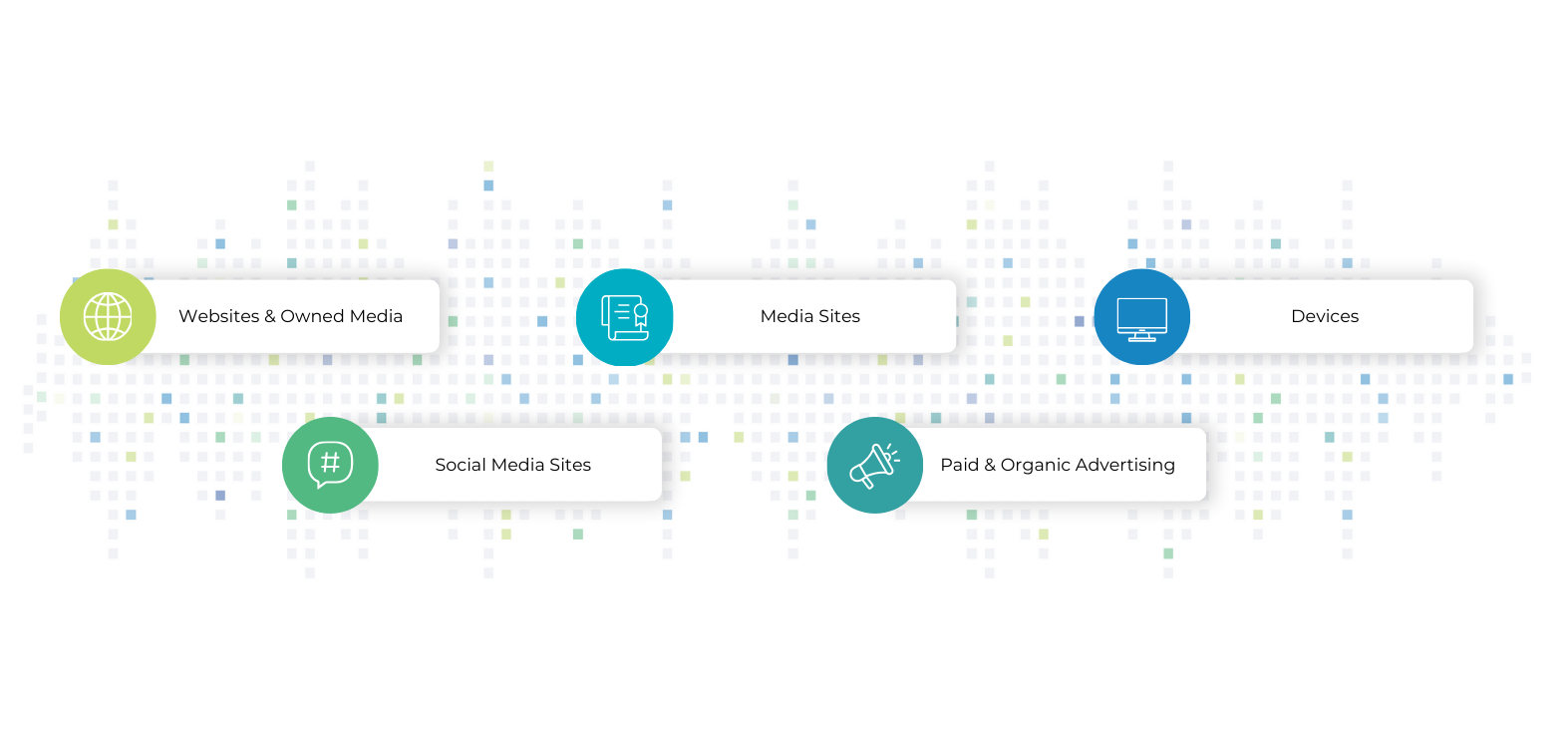
The Evolution of Digital Marketing
The Evolution of Digital Marketing
Greg Walthour, Board Member, Former Co-CEO • Intero Digital • April 23, 2024

How did we get here? How did marketing shift from a traditional, relatively linear path into an era of rapid-fire changes?
This is a good question that can be more easily understood by looking at the evolution of the broader marketing world. By exploring the phenomenal leaps that marketing has made in barely two generations, marketing professionals and business leaders can better appreciate the rise in data-driven approaches, the influence of social media, and the constant flux of consumer behavior and expectations.
Leaders can also arm themselves against common pitfalls and move forward with confidence toward whatever comes next — and not fall into the trap of digging their heads in the sand a la Blockbuster.
Most marketers, including those new to the field, know about the Blockbuster-Netflix fiasco. As Netflix’s model of digital streaming began to rise in the early 2000s, Blockbuster looked the other way. This wasn’t a matter of Blockbuster being ignorant. It was a deliberate move to stick with their existing operational model, which revolved around brick-and-mortar retail stores.
As consumers became more accustomed to digital streaming, they began migrating away from Blockbuster and toward Netflix. After all, Blockbuster was the clunky past. In contrast, Netflix was the sleek, attractive future. In 2010, Blockbuster was forced to file for bankruptcy. Netflix — well, you know how they’ve fared.
The question remains, though: How did we get here? We’re about to find the answer, starting with a birds-eye look at the differences between marketing before and after the internet.
20th-Century Marketing vs. 21st-Century Marketing: 2 Very Different Landscapes
It’s important to preface this section by noting that traditional and digital marketing aren’t completely foreign creatures. They share many similarities. For one, they stem from the same general desire: to connect brands and organizations with target audiences. Whether you were marketing in 1974 or are marketing in 2024, you’re going to be focused on educating the public and pushing out messages with a specific goal in mind (e.g., awareness, purchases, lead generation, etc.).

Where traditional and digital marketing diverge is in their speed, precision, and flexibility. Digital marketing moves fast because the digital realm moves fast. Advancements don’t happen every decade or few years; they happen practically overnight. Take TikTok, for example. In 2020, the social media app’s popularity spiked. At that moment, digital marketers with their ears to the ground knew they had to pay attention to what was happening. Conversely, digital marketers who weren’t paying attention found themselves baffled and unprepared for TikTok’s eventual influence.
The point is that it’s critical to recognize that digital marketing waits for no one. It does what it does — and marketers need to stay one step ahead of the mix. Otherwise, they’re putting themselves and their stakeholders at risk of potentially dealing with some substantial consequences and an overall forgettable marketing strategy.
The Price of Looking the Other Way on Digital Marketing’s Meteoric Rise
What’s the harm in just plugging along and not worrying about how digital marketing came to this point? Although it can be tempting to just start midstream, you’re setting yourself up for possible troubles and definitely some missed opportunities.
When you’re not clear on the timeline of an accepted or emerging digital marketing approach, such as contracting with social media influencers or using generative AI platforms for speedier keyword research, you’re doing the following:
- Giving your competitors an advantage: Be assured that your most agile, aggressive competitors aren’t interested in losing market share. They’re seeking ways to reach a wider audience and engage customers. They’d be happy to see your brand decline in relevance as consumers shift channels overnight. By not adapting with an understanding of why it’s essential to adapt, you could fail to meet your target users’ needs and preferences — and hand those users right over to another company.
- Spending money inefficiently: “Our marketing department has all the budget we need,” said no marketer ever. Ignoring digital marketing trends and the technologies that are coming down the road can lead to wild inefficiencies and wasteful endeavors. Your resources are always going to be limited. By keeping tabs on digital marketing — and becoming an expert on the subject — you’re positioning yourself to make wiser fiscal decisions that will produce better results.
- Reducing customer engagement: It’s hard enough to engage today’s customers. Millennials reportedly have a 12-second attention span. Think that’s short? Gen Z clocks in at eight seconds. Digital marketing efforts help you connect quickly in customized ways and make the most of every millisecond. That way, your brand visibility can get a lift on digital platforms, customers will enter your sales funnel, and you won’t have to worry about waning awareness or recognition.
- Lessening your credibility and reputation: Consumers expect businesses to be well-versed and savvy in digital marketing. Those that aren’t are often seen as dated and unapproachable. Even legacy brands can suffer. Look at what happened to Kodak. Once a dominant film and camera industry player, Kodak failed to keep up with the pack. The company’s 2012 bankruptcy was a stark comparison to the success its digitally forward competitors, Nikon and Canon, experienced. As a side note, a decline in reputation isn’t just a sales problem. It’s a talent-sourcing problem, too. Attracting and retaining high performers is more difficult when you’re not seen as an innovative brand.
Ouch, right?
There’s an upside, though. When you take the time to learn more about digital marketing’s trajectory, you’re going to enjoy many benefits. This includes being able to keep up with consumer preferences as they find and use different platforms, as well as meet them on those platforms when they’re most likely to engage or buy. And when you lower barriers to engagement with consumers, you boost your competitiveness. The marketing space is crowded and competitive; being known as a leader is a serious advantage.
Being a digital marketing thought leader will also help you and your brand shine. People will hear about how you’re using data to drive decision-making, how you’re reaching audiences cost-effectively, and how you’re constantly staying up-to-date with all digital marketing changes. Make no mistake: This puts the spotlight on you and your company as a powerhouse. What better place would you want to be in?
The bottom line here? You don’t need to spend years of your life learning about digital marketing’s deepest roots and nuances. However, you should move on to the next section of this article. There, you’ll learn just enough about digital marketing’s past to give you a baseline knowledge of how to rev up your digital marketing skills and initiatives for maximum outcomes.
Digital Marketing’s Most Transformative Milestones and Trends
Digital marketing class is officially in session. First, let’s take a look at some of the most important milestones of digital marketing. Each of these milestones has served as a springboard for the future of the field.

1994: If you were alive or using the internet in 1994, you may have stumbled across an advertisement on HotWired.com. This advertisement was a clickable banner ad. Before that point, no company had used clickable ads online. Soon after, the practice became a staple of digital marketing.
1998: In this year, we were introduced to Google, the top search engine in the world. Google brought about search engine optimization (SEO) and made the term “algorithm” a household word. (At least if your household included marketers.)
2000: Just two years after its launch, Google introduced AdWords so businesses could enter into pay-per-click (PPC) advertising arrangements. With PPC, companies of all sizes, from startups to enterprises, could be seen by target audiences.
2003-2004: Perhaps you’ve heard of MySpace. It was the precursor to modern social media. On its heels came Facebook, which consumed the public’s interest. People began setting up pages and communicating with one another. Businesses — and the digital marketers helping them shine — weren’t far behind.
Today: For about 10 years, AI has become more of an influence on digital marketing. For example, AI-driven chatbots whose interactions seem nearly human are commonplace. Most experts agree that within the coming decades, AI will revolutionize life (and marketing) as we know it.
The aforementioned list of digital marketing highlights is only a snapshot. Certainly, other digital marketing transformative trends have happened in recent memory. Nevertheless, these trends serve as guideposts along the digital marketing evolutionary journey. Without them, we wouldn’t have some of the most relevant and useful digital marketing tools and tactics.
- Social media influencers: This wouldn’t be possible without MySpace. Consumers trust social media personalities in a way they don’t trust brands.
- Personalization: Technologies like AI-fueled systems allow for true personalization at scale. Consumers expect to be engaged in an individualized way. AI-powered personalization allows them to connect with brands.
- Instant gratification: The rise of e-commerce has led to more informed consumers who can satisfy their need for a product or service almost immediately. Online shopping can happen in near-real time, and companies like Amazon have led the way for speedy delivery of merchandise.
- Omni-channel everything: Digital marketers are all abuzz with talk about omni-channel marketing. Again, this is a different way of looking at the customer journey. Generations ago, shoppers moved through just a few channels before making purchases. Now, they easily jump from channel to channel and even device to device. This means digital marketers need to stay on top of the channels most used by their audiences or risk wasting their advertising dollars.
- The rise of the educated consumer: Transparency is the name of the game at a time when consumers can read reviews, watch videos, and educate themselves on any subject or product. They’re no longer willing to just take companies at their word, and digital marketers need to prepare for that fact by making sure they’re pushing out educational, valuable, honest content.
Your next step? Figure out how to capitalize on these digital marketing trends for the advantage of your brand or, if you’re a marketing agency like we are, your clients. Remember: Just like the digital marketing trends of years past, your marketing strategy should always be improving and optimizing to keep up with the times.
How to Leverage Digital Marketing — One Platform at a Time
The secret behind companies that do digital marketing well is that they have a plan for every digital platform. That is, they don’t leave any online space untapped, untouched, or untested. On the contrary, they actively seek to carve out a niche on every platform that matters.

Websites and Owned Media
If you’re not hyperfocused on optimizing and improving your website and other owned media, you’re not doing digital marketing. Your website is your introduction to the world. By designing it to be a frictionless, value-filled experience, you increase your chances of engaging with visitors.
Social Media Sites
While social media pages and accounts are technically “owned media,” they deserve special recognition. Brands typically are behind the curve when it comes to social media adoption. Your goal to stay as close to what’s trending as possible and to be active and visible on the social media platforms that are most relevant for your target base. You may want to experiment with social media influencer marketing, too, as a way to promote your brand.
Media Sites
Top media sites are a wonderful place for companies to share digital content. From articles and infographics to podcasts and videos, any type of content can be delivered digitally through earned media. Media sites can be an avenue to increase your organization’s brand reputation and thought leadership as well.
Paid and Organic Advertising Mediums
Both SEO and PPC advertising are necessary areas of digital marketing. Ideally, they should work in tandem to improve your site’s visibility and ensure you get noticed when people enter specific keyword terms into their search engines. With the rise of innovations like Google’s AI Bard, search may be changing again, so stay tuned for this development!
Devices
Every device has a unique interactive platform. Because most consumers fluctuate from one device to the next, all types of devices need to be seen as essential considerations in developing digital marketing initiatives. Take apps, for instance. Leading apps like Nike Run Club and Nike Training Club offer users the chance to not just track their health achievements but to strengthen their bond with the Nike brand.
What will the next generation of influential online platforms be? There’s no way to tell. But you can bet your keyword analysis that one’s in the works right now — and the last thing you want is to struggle to transition to it like Sears did with Amazon.
Sears had once been a giant in the retail world but dragged its heels when Amazon came to town. The TL;DR version turned out to be Sears closing tons of stores and Amazon’s sales skyrocketing into the stratosphere. Fortunately, you can ensure your brand doesn’t fall into the same fate by learning from these past mistakes and using them to drive your marketing strategy into the future.
Embracing Digital Marketing Now to Prepare for What Comes Next
Unless you’ve been given the gift of prognostication, you can’t foretell tomorrow. (If you can, please connect with me because I have some ideas to run by you.) What you can do is set yourself, your company, and your team up to master digital marketing in all its forms by applying a handful of recommendations.
1. Stay updated.
By reading this guide, you’ve already started the process of being informed. You now know where digital marketing has been and where it stands today. Don’t stop learning, though. Make it a habit to attend conferences, read articles, and stay on top of digital marketing.
One suggestion from me to you: Look outside your industry when studying digital marketing. As digital marketers, we can forget to be industry agnostic. Examining how organizations from different fields are handling their digital marketing can be eye-opening.
For example, your company may never have considered using a technology like augmented reality (AR) or virtual reality (VR). What’s the harm in checking out companies in other industries that are making these advancements work for them, such as real estate? The more you know about what’s happening elsewhere, the less insular your view on digital marketing will be.
Be sure to pass on your education to highlight your digital marketing expertise. (Think of this as a “humble brag.”) You could host virtual events or live-stream webinars on topics specific to digital marketing. Not only would this become part of your overall digital marketing strategy, but it would cement you and your organization as the go-to source for digital marketing information.
2. Become obsessed with data.
OK, so you might not want to become completely obsessed, but you shouldn’t miss a chance to incorporate data into your daily decisions and long-term planning. There are so many systems and tools out there to give you tremendous insight into everything, from target customer populations to market trends. You need to make sure you’re using the right one for your needs.
As a side note, find out whether you’re actually using your preferred data systems to their fullest capacities. We’re often discovering that our clients aren’t getting the most out of their software. You may not need all the bells and whistles available to you, but you should at least be aware that they exist.
The deeper you dive into data, the more freedom you’ll discover. It’s so much easier to test and optimize all your digital marketing approaches than it ever was before. It’s also simpler to personalize all your messaging with leads and buyers.
3. Pay attention to privacy and security concerns.
One topic we haven’t addressed yet is privacy. Although many consumers are fine with handing over selective personal data in exchange for valuable content, they expect that their personal data will be protected. In fact, many regulations have arisen to hold brands accountable for being responsible with the data they collect. If you’re not familiar with the GDPR or California’s Consumer Privacy Act, read up on them now. And know that more of these rules are coming.
A general rule of thumb for you to remain compliant is to close any gaps in your marketing operations that could lead to breaches. You can work with your IT department to identify places where you may need to be more diligent about making it hard for cybercriminals to gain access to key data. The last thing you want is to spend all your time collecting consumer information only to deal with a costly breach event.
Don’t just think of this as “yet another thing” you have to do. Think of it as a way to show your target audience that you’re adopting the most ethical, thoughtful practices. Consumers today value companies that value them. By securing all the data in your midst, you’re showing you think highly of the stakeholders you serve.
4. Aim for high-quality user experiences.
The user experience (UX) matters. Rather than just concentrate all your digital marketing on trying to get people to do what you want, insist on high-quality outreach along the way. As an example, you may want to work with a marketing agency to go through a content audit so you can ensure your content is relevant and resonates with readers. Similarly, you may want to double-check your website for broken links or anything that could cause UX roadblocks.
Moving forward, keep your quality mindset at the forefront of all your campaigns. Thinking of instituting a chatbot? Test a few and then pick the one that handles queries, fetches information, and offers advice in the most impressive way.
I won’t lie: Running everything you do through a “quality meter” takes a little more time and diligence. It’ll pay off in the end, though. One thing about the digital marketing world is that what you produce will always be somewhere on the internet. Make sure it’s all a positive reflection on your company rather than an embarrassment.
5. Allot 5% to 10% of your marketing toward emerging trends.
Some digital marketing trends have the lifespan of a mature mayfly. Others take hold and won’t let go. It can be difficult to know which ones are going to be hits and which will be misses. Therefore, put about 5% to 10% of your marketing energy toward experimenting with the most compelling for your industry and audience.
For instance, you may want to try social media stories or create your own AR filter to see how your customer base reacts. Or you might want to try some form of gamification across one of your digital platforms, such as having quizzes and challenges on your website. Give your new endeavors a shot at working and then decide whether they’re worth keeping. Some will be; some won’t be. Regardless, you have tried something new, which is always welcome in digital marketing.
Take voice search optimization. The digital marketers who saw this as an opportunity to get higher rankings with natural language-style keywords had early successes. They were able to improve their discoverability while other companies weren’t looking.
6. Leverage the effectiveness of user-generated content.
What’s user-generated content (UGC)? Only one of the best ways for your brand to seem more authentic and irresistible. UGC is any content that you don’t create in-house. For instance, online reviews are UGC because they’re written by customers rather than by your team members or your content agency. This kind of content is tremendously important because it speaks about your company from an objective, third-person view.
Is all UGC completely objective? Not necessarily. Influencer-generated content is often seen as UGC but is more of a collaborative effort between you and an online social influencer. Of course, influencer contractual agreements can vary, and some influencers retain the right to say what they want. How much creative control you give your influencers is up to your discretion and comfort level.
Remember that UGC doesn’t have to exist in a vacuum. You should monitor it and respond to feedback as necessary. The last thing you want is to turn your back if you’re getting some negative UGC online. Rapidly responding in a positive, proactive, and professional way can show that your brand cares.
7. Power up your personalization.
The final digital marketing tip for you to keep in mind is to personalize interactions whenever possible. As mentioned previously, AI tools make mass personalization easier. Even videos can be personalized, so don’t think that personalization has to be relegated to static content.
What should you personalize? You could personalize your ads, your owned media content, and your email campaigns. Almost any digital marketing effort you try can probably be personalized in some capacity. Even if it’s just leveraging geofencing and location-based marketing, you’re still getting some personalization into the mix.
Chatbots can help with your personalization, as Nike’s proven. The Nike website and its social media pages use AI-powered chatbots. The chatbots are supportive, but they’re also programmed to deliver individualized responses. They’re more like guides, which makes the engagement smooth and almost human-like.
Staying at the Forefront of Digital Marketing’s Tomorrow
Now let’s ask our guiding question one more time: How did we get to this point in the marketing realm? The short answer is the emergence of the internet. The long answer is that society has changed radically, and marketing has been forced to adjust along with those changes.
It’s safe to say that traditional marketing has been completely engulfed by digital marketing. If you’re in this expressive and creative field, you know that it’s morphing all the time. However, you needn’t feel overwhelmed or underprepared.
